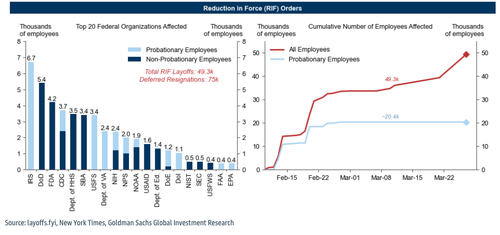Our conversation with a few institutional desks suggests a growing interest in the downstream economic impact of DOGE-related federal agency restructurings across Washington, DC—particularly with USAID neutered , the Department of Education dismantled , and numerous other agencies experiencing tens of thousands of job cuts. Additionally, the termination of federal contractors and NGO staff raises further concerns that the nation's capital—fueled mainly by taxpayer dollars— could face outsized economic disruption . Goldman Chief Economist Jan Hatzius shared new insights with clients on Sunday, unveiling an economic snapshot of the DC metro area economy through the firm's new Monthly U.
S. Government Activity —a data dashboard that monitors DC government employment, spending, and other economic trends. Hatzius said the first two months of the second Trump administration had featured federal agency restructuring, spending cuts, and federal layoffs, prompting his team to launch the monthly U.

S. Government Activity Tracker to monitor employment and spending trends. Jobs data so far indicates early signs of reduction in the government workforce, with 49.
3k employees (1.6% of the workforce) affected. This includes 21k probationary workers, along with further cuts planned at agencies like the VA, DoD, IRS, and HHS .
Initial unemployment claims for federal workers rose in late February ( read here ) and early March but have since moderated, while DC job postings on Indeed.com are down 11% since January . Hatzius noted that the broader labor market impact remains minimal.
Federal spending shows some confirmed cuts , particularly at the State Department and FCC, though total cash withdrawals from the Treasury align with historical norms. Contract awards have fallen slightly, while grant awards have stagnated below trend since Inauguration Day . Government travel has also slowed, but DC airport traffic remains stable, while DC Metrorail ridership surged as federal workers were called back to the office .
Data from Morning Consult shows consumer sentiment among federal workers has soured , especially across the DC metro area since the start of the year. Reduction in Force Orders Have Affected an Estimated 49.3k Federal Employees So Far Initial Unemployment Claims Filed by Federal Employees Remain Elevated Further RIF Layoffs Have Been Reported at the Department of Veterans Affairs, Department of Defense, and Internal Revenue Service Job Openings in Washington DC Have Declined Considerably Federal Government Job Growth Slowed to 0.
7% Year-over-year in February Total Federal Government Operating Cash Withdrawals Are Roughly On-trend...
But Spending is Undershooting in Several Key Department and Agencies Federal Contracts Activity Declined Slightly in February but Still Lies Within Normal Ranges Federal Grants Have Largely Stagnated at a Below-trend Level Since Inauguration Day Recent Company Anecdotes Highlight Negative Impacts on the Airlines and Hospitality Sectors No Signs of Decline in DC-Area Flights Weekday Metrorail Ridership Reaches a Post-pandemic High as Federal Employees Return to Office Sentiment Among Government Employees Has Declined Sharply, Especially Among Those Residing in the DC Area Market Performance of Companies Exposed to Government Spending Cuts Has Declined Since Election Day Some IT Software, Defense, and Real Estate Companies Are Cautiously Optimistic About the Efficiency-driven Spending Cuts Hatzius pointed out, "Taken together, the data captures a modest real-time impact on employment and discretionary and operational spending but otherwise suggests limited growth implications. We continue to expect these government spending cuts to have a relatively limited macroeconomic impact." Separate from Goldman, we have commented on everything from MLS housing data to jobs data , which only show that the real pain for the DC Swamp—whether in DC itself, Northern Virginia, or Maryland—has yet to hit.
.
Goldman Launches DOGE Tracker To Monitor Real-Time DC Economic Impact

Goldman Launches DOGE Tracker To Monitor Real-Time DC Economic Impact Our conversation with a few institutional desks suggests a growing interest in the downstream economic impact of DOGE-related federal agency restructurings across Washington, DC—particularly with USAID neutered, the Department of Education dismantled, and numerous other agencies experiencing tens of thousands of job cuts. Additionally, the termination of federal contractors and NGO staff raises further concerns that the nation's capital—fueled mainly by taxpayer dollars—could face outsized economic disruption.Goldman Chief Economist Jan Hatzius shared new insights with clients on Sunday, unveiling an economic snapshot of the DC metro area economy through the firm's new Monthly U.S. Government Activity—a data dashboard that monitors DC government employment, spending, and other economic trends.Hatzius said the first two months of the second Trump administration had featured federal agency restructuring, spending cuts, and federal layoffs, prompting his team to launch the monthly U.S. Government Activity Tracker to monitor employment and spending trends.Jobs data so far indicates early signs of reduction in the government workforce, with 49.3k employees (1.6% of the workforce) affected. This includes 21k probationary workers, along with further cuts planned at agencies like the VA, DoD, IRS, and HHS. Initial unemployment claims for federal workers rose in late February (read here) and early March but have since moderated, while DC job postings on Indeed.com are down 11% since January. Hatzius noted that the broader labor market impact remains minimal.Federal spending shows some confirmed cuts, particularly at the State Department and FCC, though total cash withdrawals from the Treasury align with historical norms. Contract awards have fallen slightly, while grant awards have stagnated below trend since Inauguration Day. Government travel has also slowed, but DC airport traffic remains stable, while DC Metrorail ridership surged as federal workers were called back to the office. Data from Morning Consult shows consumer sentiment among federal workers has soured, especially across the DC metro area since the start of the year. Here's the U.S. Government Activity Tracker snapshot for March: EmploymentReduction in Force Orders Have Affected an Estimated 49.3k Federal Employees So FarInitial Unemployment Claims Filed by Federal Employees Remain ElevatedFurther RIF Layoffs Have Been Reported at the Department of Veterans Affairs, Department of Defense, and Internal Revenue ServiceJob Openings in Washington DC Have Declined ConsiderablyFederal Government Job Growth Slowed to 0.7% Year-over-year in FebruarySpendingTotal Federal Government Operating Cash Withdrawals Are Roughly On-trend...But Spending is Undershooting in Several Key Department and AgenciesFederal Contracts Activity Declined Slightly in February but Still Lies Within Normal RangesFederal Grants Have Largely Stagnated at a Below-trend Level Since Inauguration DayGovernment TravelRecent Company Anecdotes Highlight Negative Impacts on the Airlines and Hospitality SectorsNo Signs of Decline in DC-Area FlightsWeekday Metrorail Ridership Reaches a Post-pandemic High as Federal Employees Return to OfficeConsumer SentimentSentiment Among Government Employees Has Declined Sharply, Especially Among Those Residing in the DC AreaMarket Performance of Companies Exposed to Government Spending Cuts Has Declined Since Election DaySome IT Software, Defense, and Real Estate Companies Are Cautiously Optimistic About the Efficiency-driven Spending CutsHatzius pointed out, "Taken together, the data captures a modest real-time impact on employment and discretionary and operational spending but otherwise suggests limited growth implications. We continue to expect these government spending cuts to have a relatively limited macroeconomic impact." Separate from Goldman, we have commented on everything from MLS housing data to jobs data, which only show that the real pain for the DC Swamp—whether in DC itself, Northern Virginia, or Maryland—has yet to hit. Tyler DurdenFri, 04/04/2025 - 07:45















